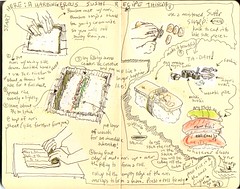Teaching America to Draw is the title of an exhibit at the Grolier Club, NYC. The NYTimes' Michael Kimmelman takes the occasion to look back upon the era when sketching was practiced by the mass of the educated class.
He asserts that, in a recent era, "Drawing promoted meditation and stillness. “A sustained act of will is essential to drawing,” Paul Valéry put it. “Nothing could be more opposed to reverie, since the requisite concentration must be continually diverting the natural course of physical movements, on its guard against any seductive curve asserting itself.”
Kimmelman rants a bit in his NYTimes story. He gathers righteous support by pointing out that "We’re addicted to convenience today. Cellphone cameras are handy, but they’re also the equivalent of fast-food meals. Their ubiquity has multiplied our distance from drawing as a measure of self-worth and a practical tool. Before box cameras became universal a century or so ago, people drew for pleasure but also because it was the best way to preserve a cherished sight, a memory, just as people played an instrument or sang if they wanted to hear music at home because there were no record players or radios. Amateurism was a virtue, and the time and effort entailed in learning to draw, as with playing the piano, enhanced its desirability."
He believes "Something happened between then (the late 1800's) and now, and it wasn’t just the invention of gadgets that eliminated the need to draw.
There was also a philosophical change, away from drawing as a practical endeavor and toward art appreciation. From dexterity and discipline to feelings and self-esteem: the shift in values is implied by some of the later books in the show. Consciously or not, they parallel changes in modern art, which threw out the rule books of draftsmanship and proposed a new, free-thinking attitude."
Kimmelman has a thesis: "With the arts, American adults have acquiesced to playing the passive role of receivers.
In a new memoir, “Let Me Finish,” Roger Angell recalls trips to the Polo Grounds and Yankee Stadium in the 1930’s with his father, who also liked to join pickup games when middle-age American men still did that. Today baseball is like the arts, with grown-ups mostly preferring not to break a sweat. “We know everything about the game now, thanks to instant replay and computerized stats, and what we seem to have concluded is that almost none of us are good enough to play it,” Mr. Angell writes.
So it is with classical music, painting and drawing, professional renditions of which are now so widely available that most people probably can’t or don’t imagine there’s any point in bothering to do these things themselves. Communities of amateurs still thrive, but they are self-selecting groups. A vast majority of society seems to presume that culture is something specialists produce."
While I see chinks in his argument (the number of books written by every Tom & Mary Jellico that are self-published and hawked upon the net, for example), I am a sympathetic listener. Of course, I'm a person who has sketched all my life. I take a notebook to museums, concerts, meetings and the beach. I sketch my environment to absorb the juicy stuff and process the heavy stuff and avoid boredom and insanity.
And I teach my students to sketch. They look at my drawings and many of them say, "No way can I copy that!" But with light-hearted encouragement they are usually successful and eventually are capturing the head of Shi Huang Di, the domes of the Taj Mahal, the scroll atop a Corinthian column.
Do you draw? What do you think of Kimmelman's argument? Read more at An Exhibition About Drawing Conjures a Time When Amateurs Roamed the Earth, July 19, 2006.

2 comments:
Awesome that you teach your students to draw. In the past I've worked with SRAC as a literary artist in residence but I also used drawing and performing to get the kids to express themselves. Back in the early 90s I learned to draw using the "Drawing with Children" book (Mona Brooks wrote it, I think). What I found was the kids who didn't want to write about trains would be inspired if we first acted out being a train and then drew pictures. I like the Drawing with Children method because it basically says if you can read you can draw. My blog has been heavy on the photos. This entry has inspired me to work towards adding some drawings to the thing.
Kathryn
I recently graduated from the Minneapolis College of Art and Design... in Graphic Design "supposedly"... but really... its only because I've drawn my whole life and have known that I always will. It blew my mind when I came back to my second year at art school and when asking what people they worked on over the summer they would be like, "oh, well, I didn't really do anything besides work/drink/or whathaveyou." I've started to understand some peoples reluctancy to draw, but It still takes me off gaurd, I know for a fact that many of those people would have benifited from the habit/practice. Art and making - as much as they sometimes are - are not solely a day job. Its consistently distributed throughout the day, through one's life, and throughout one's interaction with space and the people they share it with.
I could see a camera being a worthy substitute if it were to be approached in an appropriate manner.
thanks,
love,
erickillsforfun.com
Post a Comment